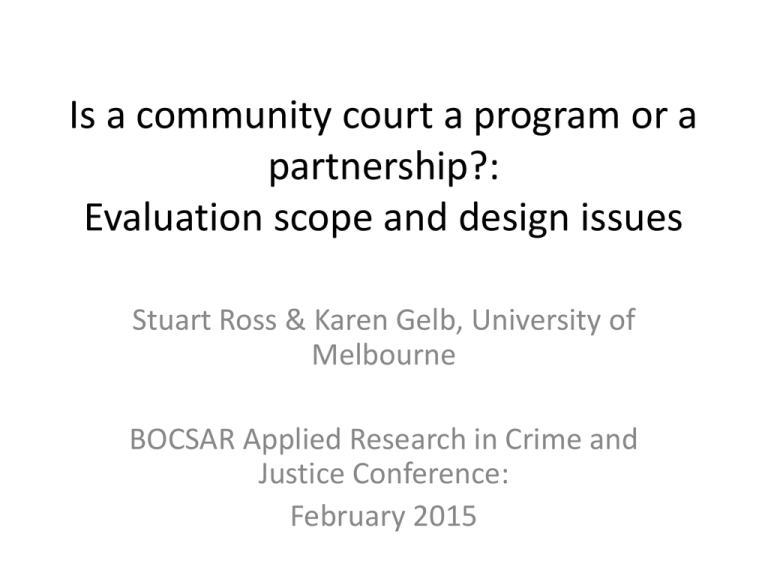Methodological considerations in measuring the effectiveness of
advertisement

Is a community court a program or a partnership?: Evaluation scope and design issues Stuart Ross & Karen Gelb, University of Melbourne BOCSAR Applied Research in Crime and Justice Conference: February 2015 Presentation outline • Summary of the T&I paper – Standard governmental evaluation metrics – Methodological problems with this approach • Problem solving courts as a form of collaborative governance • Evaluating collaborative governance – Example of Primary Care Partnerships – Translate PCP program logic into justice outcomes Criminal justice programs and partnerships • Program: a therapeutic or developmental or support intervention that targets one or a small number of related deficits – eg cognitive skills training, post-release housing • Partnership: collaborations in delivering or coordinating services that address a range of needs in a target population – common in health and human services sectors, not so common in justice – eg Primary Care Partnerships, Integrated Family Violence service networks Community justice as a partnership • NJC offers multiple rather than single interventions • NJC as an assessment and service gateway • Important outcomes take place “outside” the NJC • Community justice is a “place-based” strategy where community engagement is a core element Neighbourhood Justice Centre goals • Prevent and reduce criminal and other harmful behaviour in the City of Yarra by – Improving the community’s capacity to prevent and manage the impacts of crime/harm – providing dispute resolution and restorative justice practices – enhancing offender accountability and thereby reducing recidivism • Increase confidence in and access to the justice system for the Yarra communities through – two-way engagement between the justice sector and Yarra Communities – improving community understanding of legal and human rights – providing support services to victims of crime • Further develop the NJC justice model and facilitate the transfer of its practices to other courts and communities Program evaluation outcomes for community justice • Evaluation outcomes consistent with “program” orientation & DTF evaluation guidelines – Reduced crime rates – Improved order compliance – Reduced recidivism Limitations to this approach • The problem of attribution • Order compliance needs to take into account the risk profile of offenders • Recidivism measures also require the measurement of a range of covariates (riskdependency) and relatively large group sizes (~200) Order compliance outcomes by assessed risk level Table 1: Proportion of unsuccessful orders finalised from July 2008 to June 2011. Site Low Risk Moderate Risk High Risk Total NJC 25.6% 13.6%** 23.1%** 22.8%* Comparison 1 19.3% 34.0% 61.5% 29.7% Comparison 2 14.9%** 36.5% 62.7% 30.9% Comparison 3 18.9% 42.6% 72.7% 37.0%* Comparison 4 23.5%* 40.4% 63.9% 37.4%* State-wide 18.1% 35.3% 59.9% 30.1% Survival functions for NJC and matched comparison group Evaluating collaborative interventions at the NJC • Multiple versus single interventions • Need to be able to scale the investment in each participant and look for the relationship between this investment and the individual and social outcomes that are produced • Service gateway role • • • Engagement and retention rates for services delivered within and outside the NJC Does partnership-based referral change the quality of service provider interactions with clients? (eg as a result of compliance reporting obligations) Positive or negative interactions with other service requirements Evaluating collaborative interventions at the NJC • Measuring outcomes that take place “outside” the NJC – Compliance or retention with treatment/support services – Self-directed care – Long-term (> 1 year) health, mental health, housing outcomes, financial security • Community justice is a “place-based” strategy where community engagement is a core element – Engagement with local organisations/social capital – Service integration outcomes Challenges for evaluating collaborative interventions • Need for more developed theory around partnership based interventions – Eg integrated family violence services • “Hidden” and indirect costs and benefits: allocative and distributional transfer effects – How much of the outcomes from community justice represent new versus transferred outcomes? – Do CJS initiated outcomes compete with outcomes in other sectors? (eg Housing) What is the counter-factual? • Measuring the costs of doing nothing – Conventional CBA analysis examines monetised benefits of outcomes against marginal costs (usually costs of avoided negative outcomes versus intervention supply costs) • But costs of “doing nothing” are not necessarily zero. – Access Economics estimate for annual cost of family violence of $4.5 billion, homelessness costs of $1M to $5.5M per person to age 21 – But we lack “do nothing” estimates of the cost of many forms of social problems and disadvantage Application to other justice partnership/programs Potential application of this approach to partnership/programs that offer multiple interventions, act as a service gateway, where outcomes take place outside the program boundary: • Integrated family violence service networks • Post-release support programs • Multi-systemic therapy approaches in juvenile justice • Criminal justice / mental health programs








